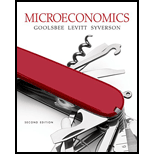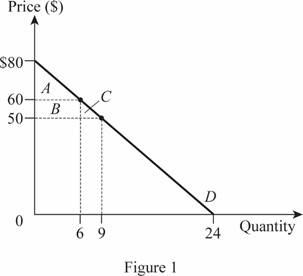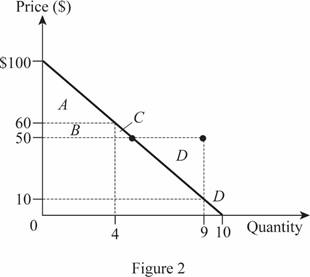
(a)
The
(a)
Explanation of Solution
The
Marginal revenue equation can be derived as follows.
Since the marginal revenue will have double slope value, the marginal revenue curve of the frequent golfer will be
The marginal cost is $20. The profit maximizing price of the frequent golfers can be calculated by equating the marginal revenue with the marginal cost as follows:
Thus, the equilibrium quantity is 9. It can be plugged into the price equation to calculate the price as follows:
Thus, the profit maximizing price from the frequent golfers is equal to $50. The total profit that the club could make from the frequent golfers can be calculated as follows:
Thus, the club could make a profit of $270 from the frequent golfers. The price charged from the frequent golfers is equal to $50 and the optimal quantity of rounds of gold demanded by frequent golfers is 9. Similarly, the price, quantity and the profit from the infrequent golfers can be calculated as follows:
The demand from the infrequent golfer is given by
Marginal revenue equation can be derived as follows.
The marginal revenue curve of the frequent golfer is
The marginal cost is $20. The profit maximizing price of the infrequent golfers can be calculated by equating the marginal revenue with the marginal cost as follows:
Thus, the equilibrium quantity is 4. It can be plugged into the price equation to calculate the price as follows:
Thus, the profit maximizing price from the infrequent golfers is equal to $60. The total profit that the club could make from the infrequent golfers can be calculated as follows:
Thus, the club could make a profit of $160 from the infrequent golfers. The price charged from the infrequent golfers is $60 per round and the quantity demanded by them is only 4 rounds. Thus, the total profit that the firm could make can be calculated as follows:
Thus, the club could make a total profit of $430 from the two group of consumers.
(b)
The price for the individual round of golf.
(b)
Explanation of Solution
When the club is not possible to tell which consumer is a frequent golfer and which consumer is an infrequent golfer, the club should set a price which is equal to the price of $60. The marginal cost and the marginal revenue of the infrequent consumers equals at $60 which means it maximizes the profit of the club.
(c)
The price for the individual round of golf in discount plan.
(c)
Explanation of Solution
When the club is planning to maximize their profit through a discount plan, then the club should follow the method of quantity discounting where the minimum quantity limit should be set. The price should be $50 per round when the minimum of 9 rounds is demanded to be eligible for the discounts. This is the profit maximizing price from the frequent golfers. Those who are not demanding this minimum quantity should be charged $60 per round.
(d)
The
(d)
Explanation of Solution
The inverse demand curve of the frequent golfers can be illustrated as follows:

When the individual rounds are priced $60 for each round, the frequent golfers demands for 6 rounds and when the discounted price is offered, they go for 9 rounds. Thus, the consumer surplus from the individual pricing will be equal to the area of A which can be calculated as follows:
Thus, the consumer surplus of the frequent golfers under the individual pricing is $60. When the price is discounted, the consumer surplus becomes the area of A+B+C and it can be calculated as follows:
Thus, the consumer surplus of the frequent golfers from the discounted pricing is $135. This means that the consumer surplus is maximum for the frequent golfers under the discounted pricing.
(e)
The consumer surplus of the infrequent golfers under the two schemes.
(e)
Explanation of Solution
The inverse demand curve of the frequent golfers can be illustrated as follows:

When the individual rounds are priced $60 for each round, the infrequent golfers demands for 4 rounds and when the discounted price is offered, they go for 5 rounds. Thus, the consumer surplus from the individual pricing will be equal to the area of A which can be calculated as follows:
Thus, the consumer surplus of the infrequent golfers under the individual pricing is $80. When the price is discounted, the infrequent consumers have to go for 9 rounds. When the price is $50, the ordinary infrequent golfers would go for 5 rounds and thus, the consumer surplus for 5 rounds can be calculated as follows:
Thus, the consumer surplus of the infrequent golfers from the discounted pricing is $125. But this option will not be possible because the discounted price is applicable only when the infrequent consumers demand for 9 rounds. This means that the infrequent golfers has to go for 4 additional rounds which creates a negative consumer surplus to the infrequent golfers equal to the area of D. The area of D can be calculated as follows:
Thus, the total surplus of the infrequent golfers from the discounted plan can be calculated by summating the positive and negative consumer surpluses as follows:
Thus, the total consumer surplus from the discounted plan to the infrequent golfers is only $45 which is lower than that of the individual pricing. Thus, the infrequent golfers would go for the individual pricing strategy.
(f)
The successful plan for the frequent and infrequent golfers.
(f)
Explanation of Solution
When the club offers the individual pricing and the discounted plans, the frequent golfers would go for the discounted plan as it maximizes their consumer surplus and the infrequent golfers go for the individual plan as it is the plan that maximizes their consume surplus. Thus, self selecting option is more successful in the club.
(g)
The successful plan for the frequent and infrequent golfers when the type of player is indicated.
(g)
Explanation of Solution
When the club is able to identify the type of players, the club could charge $50 for frequent golfers and $60 for infrequent golfers rather than offering a self select option. But the profit made by the club would be exactly the same as self select option.
Want to see more full solutions like this?
Chapter 10 Solutions
Microeconomics
- Explain Professor Frederick's "cognitive reflection" test.arrow_forward11:44 Fri Apr 4 Would+You+Take+the+Bird+in+the+Hand Would You Take the Bird in the Hand, or a 75% Chance at the Two in the Bush? BY VIRGINIA POSTREL WOULD you rather have $1,000 for sure or a 90 percent chance of $5,000? A guaranteed $1,000 or a 75 percent chance of $4,000? In economic theory, questions like these have no right or wrong answers. Even if a gamble is mathematically more valuable a 75 percent chance of $4,000 has an expected value of $3,000, for instance someone may still prefer a sure thing. People have different tastes for risk, just as they have different tastes for ice cream or paint colors. The same is true for waiting: Would you rather have $400 now or $100 every year for 10 years? How about $3,400 this month or $3,800 next month? Different people will answer differently. Economists generally accept those differences without further explanation, while decision researchers tend to focus on average behavior. In decision research, individual differences "are regarded…arrow_forwardDescribe the various measures used to assess poverty and economic inequality. Analyze the causes and consequences of poverty and inequality, and discuss potential policies and programs aimed at reducing them, assess the adequacy of current environmental regulations in addressing negative externalities. analyze the role of labor unions in labor markets. What is one benefit, and one challenge associated with labor unions.arrow_forward
- Evaluate the effectiveness of supply and demand models in predicting labor market outcomes. Justify your assessment with specific examples from real-world labor markets.arrow_forwardExplain the difference between Microeconomics and Macroeconomics? 2.) Explain what fiscal policy is and then explain what Monetary Policy is? 3.) Why is opportunity cost and give one example from your own of opportunity cost. 4.) What are models and what model did we already discuss in class? 5.) What is meant by scarcity of resources?arrow_forward2. What is the payoff from a long futures position where you are obligated to buy at the contract price? What is the payoff from a short futures position where you are obligated to sell at the contract price?? Draw the payoff diagram for each position. Payoff from Futures Contract F=$50.85 S1 Long $100 $95 $90 $85 $80 $75 $70 $65 $60 $55 $50.85 $50 $45 $40 $35 $30 $25 Shortarrow_forward
- 3. Consider a call on the same underlier (Cisco). The strike is $50.85, which is the forward price. The owner of the call has the choice or option to buy at the strike. They get to see the market price S1 before they decide. We assume they are rational. What is the payoff from owning (also known as being long) the call? What is the payoff from selling (also known as being short) the call? Payoff from Call with Strike of k=$50.85 S1 Long $100 $95 $90 $85 $80 $75 $70 $65 $60 $55 $50.85 $50 $45 $40 $35 $30 $25 Shortarrow_forward4. Consider a put on the same underlier (Cisco). The strike is $50.85, which is the forward price. The owner of the call has the choice or option to buy at the strike. They get to see the market price S1 before they decide. We assume they are rational. What is the payoff from owning (also known as being long) the put? What is the payoff from selling (also known as being short) the put? Payoff from Put with Strike of k=$50.85 S1 Long $100 $95 $90 $85 $80 $75 $70 $65 $60 $55 $50.85 $50 $45 $40 $35 $30 $25 Shortarrow_forwardThe following table provides information on two technology companies, IBM and Cisco. Use the data to answer the following questions. Company IBM Cisco Systems Stock Price Dividend (trailing 12 months) $150.00 $50.00 $7.00 Dividend (next 12 months) $7.35 Dividend Growth 5.0% $2.00 $2.15 7.5% 1. You buy a futures contract instead of purchasing Cisco stock at $50. What is the one-year futures price, assuming the risk-free interest rate is 6%? Remember to adjust the futures price for the dividend of $2.15.arrow_forward
- 5. Consider a one-year European-style call option on Cisco stock. The strike is $50.85, which is the forward price. The risk-free interest rate is 6%. Assume the stock price either doubles or halves each period. The price movement corresponds to u = 2 and d = ½ = 1/u. S1 = $100 Call payoff= SO = $50 S1 = $25 Call payoff= What is the call payoff for $1 = $100? What is the call payoff for S1 = $25?arrow_forwardMC The diagram shows a pharmaceutical firm's demand curve and marginal cost curve for a new heart medication for which the firm holds a 20-year patent on its production. Assume this pharmaceutical firm charges a single price for its drug. At its profit-maximizing level of output, it will generate a total profit represented by OA. areas J+K. B. areas F+I+H+G+J+K OC. areas E+F+I+H+G. D. - it is not possible to determine with the informatio OE. the sum of areas A through K. (...) Po P1 Price F P2 E H 0 G B Q MR D ōarrow_forwardPrice Quantity $26 0 The marketing department of $24 20,000 Johnny Rockabilly's record company $22 40,000 has determined that the demand for his $20 60,000 latest CD is given in the table at right. $18 80,000 $16 100,000 $14 120,000 The record company's costs consist of a $240,000 fixed cost of recording the CD, an $8 per CD variable cost of producing and distributing the CD, plus the cost of paying Johnny for his creative talent. The company is considering two plans for paying Johnny. Plan 1: Johnny receives a zero fixed recording fee and a $4 per CD royalty for each CD that is sold. Plan 2: Johnny receives a $400,000 fixed recording fee and zero royalty per CD sold. Under either plan, the record company will choose the price of Johnny's CD so as to maximize its (the record company's) profit. The record company's profit is the revenues minus costs, where the costs include the costs of production, distribution, and the payment made to Johnny. Johnny's payment will be be under plan 2 as…arrow_forward

 Principles of Economics (12th Edition)EconomicsISBN:9780134078779Author:Karl E. Case, Ray C. Fair, Sharon E. OsterPublisher:PEARSON
Principles of Economics (12th Edition)EconomicsISBN:9780134078779Author:Karl E. Case, Ray C. Fair, Sharon E. OsterPublisher:PEARSON Engineering Economy (17th Edition)EconomicsISBN:9780134870069Author:William G. Sullivan, Elin M. Wicks, C. Patrick KoellingPublisher:PEARSON
Engineering Economy (17th Edition)EconomicsISBN:9780134870069Author:William G. Sullivan, Elin M. Wicks, C. Patrick KoellingPublisher:PEARSON Principles of Economics (MindTap Course List)EconomicsISBN:9781305585126Author:N. Gregory MankiwPublisher:Cengage Learning
Principles of Economics (MindTap Course List)EconomicsISBN:9781305585126Author:N. Gregory MankiwPublisher:Cengage Learning Managerial Economics: A Problem Solving ApproachEconomicsISBN:9781337106665Author:Luke M. Froeb, Brian T. McCann, Michael R. Ward, Mike ShorPublisher:Cengage Learning
Managerial Economics: A Problem Solving ApproachEconomicsISBN:9781337106665Author:Luke M. Froeb, Brian T. McCann, Michael R. Ward, Mike ShorPublisher:Cengage Learning Managerial Economics & Business Strategy (Mcgraw-...EconomicsISBN:9781259290619Author:Michael Baye, Jeff PrincePublisher:McGraw-Hill Education
Managerial Economics & Business Strategy (Mcgraw-...EconomicsISBN:9781259290619Author:Michael Baye, Jeff PrincePublisher:McGraw-Hill Education





